Antico: The Golden Age of Renaissance Bronzes
May 1, 2012, through July 29, 2012
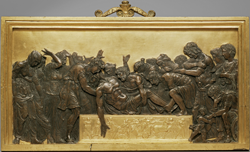 |
|
Mantuan, attributed to Gian Marco Cavalli (c. 1454–after 1508)
The Entombment
c. 1480
Bronze with fire gilding and silvered details;
integrally cast frame and finial Kunsthistorisches Museum, Vienna, Kunstkammer
|
Gonzaga devotion to the Mantuan relic of the Holy Blood probably inspired this depiction of Christ's heroic body lowered into the tomb. At left, Mary, his mother, collapses in grief. At right, Longinus, the centurion who drew Christ's blood at the Crucifixion, sits hunched in sorrow. The scene's dark violence contrasts with the serene classicism of the sarcophagus figures, gilded background, and frame. The recent attribution of this work to Gian Marco Cavalli suggests that this goldsmith, who worked with Antico, was an artist of extraordinary talent. Antico rarely executed religious subjects, and none survive. He expressed his mastery of narrative relief on the Gonzaga Urn displayed nearby in the Cabinet Gallery.
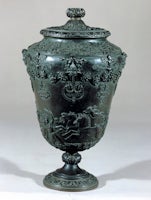 |
|
Gonzaga Urn
c. 1487
Finial at top missing; foot probably a modern
replacement
Bronze
Galleria Estense, Modena
|
This bronze was intended solely for display. It
evokes ancient Roman marble cinerary urns to
commemorate the rulership of Gianfrancesco
Gonzaga and his wife, Antonia del Balzo. Military
trophies rimming the top laud Gianfrancesco's martial
achievements. His motto, PROBITAS LAVDATVR (Virtue
is praised) is suspended from a beautiful mask, as
is Antonia's watchword, MAI PIV (Nevermore).
These mottos — and the Gonzaga thunderbolt device —
reoccur on the couple's nearby portrait medals. At the
urn's base, Neptune, god of the seas, leads a triumphal
procession. The lusty deities and sea horses are
modeled with remarkable vigor. On classical
sarcophagi sea-triumphs symbolized eternity; on
the urn this sensuous relief celebrates the enduring
vitality of Gonzaga rule.
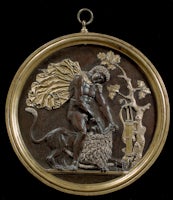 |
|
Hercules and the Nemean Lion
c. 1496
Bronze with fire gilding and silvering on tassel of cloak; integrally cast frame
Museo Nazionale del Bargello, Florence
|
Hercules, son of Jupiter and a mortal woman, atoned for his crimes by performing twelve labors. In the first he vanquished the Nemean lion whose skin was magically impenetrable. Antico shows Hercules killing the beast by snapping apart its jaws. The hero's muscles are flexed; his golden cloak flares behind him. The detail and gilding on both these early roundels demonstrate Antico's superlative skills as a bronze sculptor and goldsmith. He and his associates executed five roundels of Hercules' deeds that might have been intended as a series or, as they are displayed here, as separate pairs made for individual Gonzaga patrons.
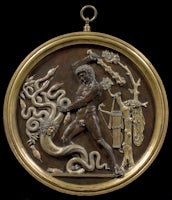 |
|
Hercules and the Lernaean Hydra
c. 1496
Bronze with fire gilding; integrally cast frame
Museo Nazionale del Bargello, Florence
|
In the second of his twelve labors Hercules destroyed the multiheaded hydra of Lerna, a creature feared to be invincible because each time a head was severed others grew in its place. Unlike the classical myth, but like the reverses of ancient coins, Antico depicts Hercules killing the beast by smashing its heads with his club. Antico renders the coiling body and writhing serpent heads with vivid naturalism, contrasting the creature's mindless vitality with its anguished human face. In the Frick statuette of Hercules, the aged hero wears a poplar crown that recalls the sprouting leaves from this scene of his youthful victory.
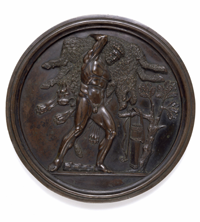 |
|
Hercules and the Erymanthian Boar
c. 1496
Bronze; integrally cast frame
Victoria and Albert Museum, London
|
Hercules, son of Jupiter and a mortal woman, atoned for his crimes by performing twelve labors that tested his strength, perseverance, and wit. In the third, he captured a giant boar that had ravaged the land. Antico depicts Hercules heroically nude bearing the struggling beast on his shoulder. His attribute of the lion's skin flutters behind him, its dead mask echoing the bellowing boar. Antico and his associates executed five roundels of Hercules' deeds, which might have been intended as a series or, as they are shown here, as separate pairs made for individual Gonzaga patrons. The roundel type and its flat platform ground-line derive from the reverses of ancient coins.
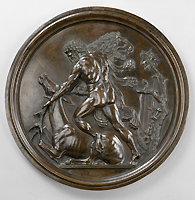 |
|
Hercules and the Ceryneian Hind
c. 1496
Bronze; integrally cast frame Kunsthistorisches Museum, Vienna, Kunstkammer
|
In his fourth labor Hercules captured the magically fleet Ceryneian hind. He pins down its back and snaps off an antler, subduing the creature in a feat of strength. Antico intensifies the drama by manipulating the depth of relief. The hind's broken antler projects forward, while Hercules' lion's skin, in low relief, claws the air in the background. This roundel may have been composed as a companion to the one at left. Together they present the muscular hero from back and front and seem dramatically outsized versions of the reverses of small ancient coins. Hercules' deeds were ancient emblems of virtue; Antico's splendid roundels associate the virtues of Gonzaga rulership with a classical heritage writ large.
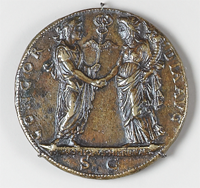
|
|
1. Cristoforo di Geremia (active 1456–1476)
Constantine the Great (obverse) Concordia Augustorum (reverse shown)
1468
Bronze
Dr. Stephen K. and Janie Woo Scher Collection
|
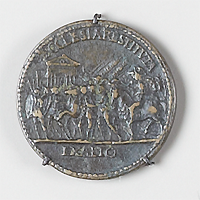 |
|
2. Cristoforo di Geremia (active 1456–1476)
Ludovico Scarampi (obverse)
Triumphal Procession (reverse shown)
c. 1439–40
Bronze
Dr. Stephen K. and Janie Woo Scher Collection |
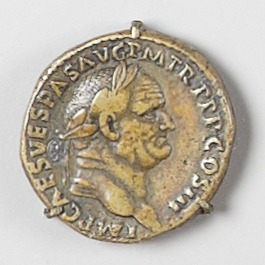 |
|
3. Roman
Sestertius of Vespasian (69–79) (obverse shown)
Salus (reverse)
AD 71
Bronze with silver eagle inlay on obverse
Dr. Stephen K. and Janie Woo Scher Collection
|
 |
|
4. Roman
Sestertius of Galba (68–69)
(obverse)
Victory (reverse shown)
June–August AD 69
Bronze with silver eagle inlay on obverse
Dr. Stephen K. and Janie Woo Scher Collection
|
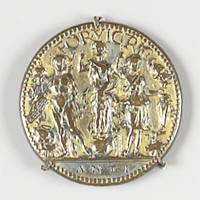 |
|
5a. Gianfrancesco Gonzaga di Ròdigo
(obverse)
Fortune, Mars, and Minerva
(reverse shown)
c. 1486–90 Bronze, modern gilding
Dr. Stephen K. and Janie Woo Scher Collection
|
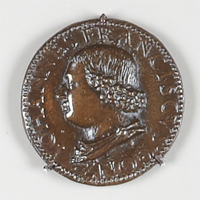 |
|
5b. Gianfrancesco Gonzaga di Ròdigo
(obverse shown)
Fortune, Mars, and Minerva
(reverse)
c. 1486–90
Bronze
National Gallery of Art, Washington, D.C., Widener Collection
|
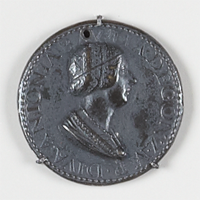 |
|
6a. Antonia del Balzo (obverse shown)
Hope on the Prow of a Broken-Masted Vessel (reverse)
c. 1487
Bronze
Dr. Stephen K. and Janie Woo Scher Collection
|
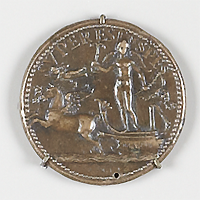 |
|
6b. Antonia del Balzo (obverse)
Hope on the Prow of a Broken-Masted Vessel (reverse shown)
c. 1487
Bronze
National Gallery of Art, Washington, D.C., Widener Collection
|
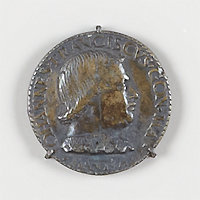 |
|
7. Attributed to Antico
Gianfrancesco Gonzaga di Ròdigo (obverse shown)
Trinacria (reverse)
c. 1478
Bronze
National Gallery of Art, Washington, D.C., Widener Collection
|
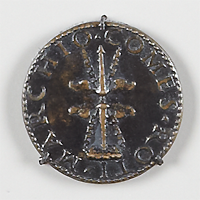 |
|
8. Gianfrancesco Gonzaga di Ròdigo (obverse)
Thunderbolt (reverse shown)
c. 1479–82
Bronze
Collection of Andrew Brown
|
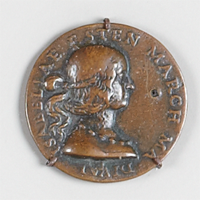 |
|
9. Gian Cristoforo Romano (1465–1512)
Isabella d'Este (uniface)
1498
Bronze
Dr. Stephen K. and Janie Woo Scher Collection
|
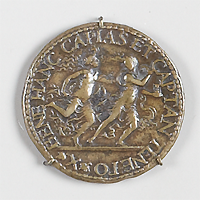 |
|
10. Style of Antico Maddalena Mantuana (obverse)
Maddalena in Pursuit of Occasion (reverse shown)
1504
Bronze
Dr. Stephen K. and Janie Woo Scher Collection
|
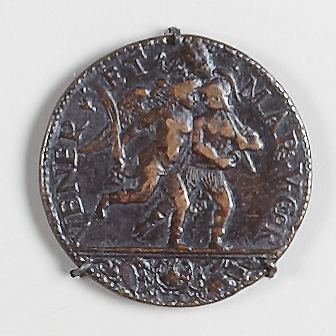 |
|
11. Style of Antico Luca de Zuhari (obverse)
Venus and Mars (reverse shown)
Probably 1490–1520
Bronze
Dr. Stephen K. and Janie Woo Scher Collection
|
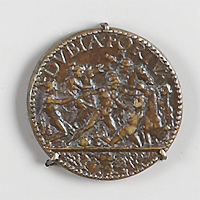 |
|
12. Diva Julia (obverse)
Battle Scene (reverse shown)
c. 1490
Bronze
National Gallery of Art, Washington, D.C., Samuel H. Kress Collection
|
|


